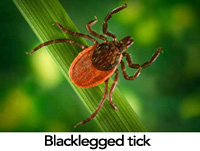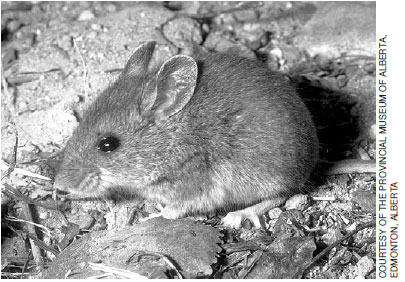
Manitoba public health officials advise you to enjoy your spring and summer activities with the awareness that outdoor activities can increase the risk of exposure to some infectious diseases such as:
- West Nile virus,
- Lyme disease,
- E. coli,
- rabies,
- hantavirus and
- blastomycosis
Manitobans can take precautions to reduce these risks by:
- preparing for West Nile virus season by reducing standing water around their homes;
- avoiding contact with blacklegged (deer) ticks to reduce their risk of Lyme disease;
- taking proper food-handling precautions to reduce food-borne infections;
- testing wells regularly, particularly if the well has been affected by flooding, to reduce water-borne infections;
- vaccinating pets and avoiding handling wildlife to reduce the risk of rabies;
- avoiding exposure to mouse droppings to reduce the risk of hantavirus infections; and
- being aware of the risk for exposure to blastomycosis from fungal spores found in soil in risk areas.
More information about these health issues is available in the following backgrounder.
Manitoba Backgrounder
West Nile Virus

Mosquitoes are starting to appear. At this time, the risk of being bitten by a mosquito carrying West Nile virus is considered very low but this risk will increase as the weather gets warmer. The majority of the mosquitoes active at this time of year are not Culex tarsalis, which is the main species known to carry West Nile virus in Manitoba.
Mosquito surveillance for West Nile virus will begin in most surveillance communities this weekend with the exception of surveillance areas affected by flooding.
Manitobans can prepare for mosquito season by reducing standing water around their homes, which helps prevent the development of Culex tarsalis mosquitoes. This includes:
- cleaning eavestroughs and regularly emptying bird baths and other items that might collect water,
- ensuring rain barrels are covered with mosquito screening or are tightly sealed around the downspout,
- clearing yards of old tires or other items that collect water, and
- improving landscaping to prevent standing water around the home.
The risk of exposure to this virus varies from year to year. Human exposure has occurred from June to September, with most exposures occurring in July and August. During these times, Manitobans can reduce the risk of mosquito bites by:
- reducing the amount of time spent outdoors between dusk and dawn;
- using appropriate mosquito repellent;
- wearing light-coloured, loose-fitting clothing; and
- maintaining door and window screens so they fit tightly and are free of holes.
Usually, people infected with West Nile virus have no symptoms and do not become ill. Milder symptoms of West Nile virus (non-neurological syndrome), which can include fever, headaches, fatigue and body aches, usually improve without medical care.
Less frequently, the virus can cause more serious illness (West Nile neurological syndrome), including encephalitis, an inflammation of the brain. Encephalitis can have serious complications, including weakness, paralysis, confusion, coma or death. People with pre-existing medical conditions and older adults are more at risk for severe illness.
Anyone experiencing severe symptoms (for example, persistent high fever, muscle weakness or headache) should seek medical attention promptly.
Human cases of West Nile virus were first identified in Manitoba in 2003. The annual number of severe cases (West Nile virus neurological syndrome) in Manitoba has ranged from zero to 72. West Nile virus-related deaths have ranged from zero to four per year.
Manitoba Health will continue to provide the public with information on the risk of West Nile virus through public education, media updates and by posting information online throughout the summer.
More information about West Nile virus is available by visiting the Manitoba Health website at www.gov.mb.ca/health/wnv.
Lyme Disease

Lyme disease is a bacterial infection people can get from the bite of an infected blacklegged (deer) tick. Blacklegged ticks can be found from April to November. These ticks are smaller in size than the common dog (wood) tick, which does not transmit Lyme disease.
Symptoms of Lyme disease can start about three days to one month after a tick bite, often with an expanding circular rash which then fades. Early symptoms can also include headache, stiff neck, fever, muscle aches or fatigue.
People who think they may have Lyme disease should see their doctor promptly. Lyme disease can be successfully treated with antibiotics and treatment is most successful in the early stages of infection.
Throughout Manitoba, there is a chance of being exposed to Lyme disease through contact with infected blacklegged ticks deposited by birds. However, there is a greater risk in the southeast corner of the province and in the Stanley Trail area where infected blacklegged tick populations are established.
Manitobans can reduce their contact with blacklegged ticks by:
- limiting contact with tall grass or other vegetation along wooded areas and staying to the centre of hiking trails or paths;
- wearing light-coloured clothing to make it easier to see ticks that may be on skin or clothing;
- wearing long pants and a long-sleeved shirt in tall-grass habitats or wooded areas where ticks are most commonly found;
- tucking a shirt into pants and pants into socks to prevent ticks from attaching to the skin;
- applying an appropriate repellent, labeled as tick repellent on the container, on clothing and exposed skin after reading and following instructions for use;
- inspecting themselves, children and pets for ticks and removing them as soon as possible; and
- keeping grass well mowed to help reduce the amount of habitat suitable for ticks.
The risk of catching Lyme disease from a blacklegged tick is reduced if it is removed early, especially within 24 hours. If a tick is attached to skin, carefully remove it with tweezers. Grasp the tick close to the skin and pull slowly upward with steady pressure. Avoid twisting or crushing the tick. Cleanse the skin around the tick bite with soap and water or a disinfectant. Mark the date and location of the bite on your calendar.
For more information, visit www.gov.mb.ca/health/lyme/index.html.
E. Coli and Other Food- or Water-borne Infections
‘Hamburger disease’ results from infection with a specific strain of E. coli bacteria. The most commonly reported source of this infection in Manitoba is contaminated ground beef that has been improperly handled or prepared. Other potential sources of this infection can include contaminated well water or person-to-person contact. Symptoms start from two to 10 days after exposure and most commonly include watery diarrhea that may become bloody. There may also be cramps, vomiting and mild fever. Severe cases can result in kidney failure or death.
In Manitoba, there are about 70 cases of E. coli infection reported each year. To reduce the risk of illness due to E. coli or other food-borne infections, proper food-handling precautions should be taken to avoid exposure to undercooked meat or other foods or items that have been in contact with raw meat. It is important to thoroughly wash all utensils, dishes, cutting boards and countertops that have come in contact with raw meat.
Manitobans are advised to cook ground beef until it is well done and follow guidelines for cooking other meat. Properly cooking meat, especially ground beef, kills the E. coli bacteria. Refrigerate or freeze meat as soon as possible after buying and always wash hands after handling raw meat.
To lower the risk of illnesses that can be caused by contaminated water, well users should check that their well is safe from sources of contamination. Well testing should be done regularly, particularly if the well has been affected by flooding. For more information about well‑water safety, visit:
www.gov.mb.ca/health/publichealth/environmentalhealth/water.html.
Visit www.manitoba.ca for more information if your well has been affected by flood water.
Information on hamburger disease is available at:
www.gov.mb.ca/health/publichealth/ecolifs.html
More information about safe food handling can be found at:
www.inspection.gc.ca/english/fssa/concen/tipcon/thermoe.shtml or
www.gov.mb.ca/agriculture/foodsafety/consumer/cfs01s04.html.
Rabies
Rabies is a disease caused by a virus carried in the saliva of an infected animal. Rabies is spread when infected animal saliva gets under the skin (usually by a bite) or on the mucous membranes such as the lining of the mouth, nose or eyes.
Wild animals that are most likely to carry rabies include bats, skunks, raccoons and foxes. Domestic animals, particularly dogs and cats, and farm animals such as horses and cows can get rabies from contact with infected animals.
Vaccination and rabies immune globulin given shortly after a bite can prevent the development of rabies, which is otherwise usually fatal. Each year, rabid animals are identified in the province and human exposures treated. However, human cases of rabies are rare and no cases have been reported in Manitoba for many years.
Manitobans can reduce the risk of rabies by vaccinating pets and avoiding handling wildlife. Individuals who have been bitten by domestic or wild animals should see their health-care provider or contact Health Links–Info Santé at 788-8200 (in Winnipeg) or at 1‑888-315-9257 (toll-free) for advice on wound care and rabies risk.
For more information about rabies, go to:
www.gov.mb.ca/health/publichealth/cdc/fs/rabies.pdf.
Hantavirus

Hantavirus infection is a rare viral disease which can be fatal. In Manitoba, the virus is found in urine, feces and saliva of infected deer mice. There have been three human cases reported in Manitoba since 1999 including two deaths. The most recent case was reported in 2007. Hantavirus infection usually occurs when people breathe in the air-borne virus. This exposure usually occurs in enclosed spaces. Symptoms usually develop a few weeks after exposure. Initial symptoms are flu-like including fever, muscle aches and abdominal pain, which can be followed by shortness of breath.
People can take precautions to prevent exposure to hantavirus by:
- rodent-proofing buildings;
- airing out enclosed areas as much as possible before entering; and
- taking precautions during cleanup of areas that may be contaminated with the virus including:
- wearing gloves and appropriate masks;
- dampening areas contaminated with rodent droppings with bleach disinfectant and removing droppings with a damp mop or cloth to reduce the chance the virus may become airborne; and
- washing hands thoroughly after cleanup is complete.
More information on hantavirus can be found at:
www.gov.mb.ca/health/publichealth/cdc/fs/Hantavirusfs.pdf.
Blastomycosis
Blastomycosis is an infection caused by a fungus found in acidic, moist soil mainly in areas around the Great Lakes and Mississippi River, northwestern Ontario and areas around the Manitoba-Ontario border. Infection can occur by breathing in the fungus or by letting it contact a scrape or cut.
Symptoms can include cough, muscle aches, joint pain, fever, chills, tiredness or skin infections. Symptoms often appear gradually weeks or months after exposure. It is not a common disease, which can make diagnosis difficult. People experiencing these symptoms should see a doctor and are encouraged to tell a doctor if they have travelled to an area where blastomycosis fungi are found to help in the diagnosis.
Blastomycosis is not passed by animals to humans or from person-to-person. It can be effectively treated with specific anti-fungal medication.
Although there is little evidence of effectiveness, people can take precautions including wearing gloves and other protective clothing, and using a dust mask when working in areas where the fungus may exist.
Since blastomycosis became reportable in Manitoba in 2006, 50 cases have been reported to Manitoba Health.
More information on blastomycosis can be found at:
www.gov.mb.ca/health/publichealth/cdc/fs/blastomycosis.pdf.
Enjoy a Healthy and Safe Spring & Summer!
Manitoba, Ontario, Canada
Manitoba News Release
May 20, 2011
PUBLIC HEALTH SPRING/SUMMER REMINDERS
Manitoba public health officials are encouraging Manitobans to take advantage of spring and summer by enjoying outdoor activities, increasing physical activity and eating healthy including more local fresh foods.
However, spring and summer outdoor activities can increase the risk of exposure to some infectious diseases such as West Nile virus, Lyme disease, E. coli, rabies, hantavirus and blastomycosis.
Manitobans can take precautions to reduce these risks by:
- preparing for West Nile virus season by reducing standing water around their homes;
- avoiding contact with blacklegged (deer) ticks to reduce their risk of Lyme disease;
- taking proper food-handling precautions to reduce food-borne infections;
- testing wells regularly, particularly if the well has been affected by flooding, to reduce water-borne infections;
- vaccinating pets and avoiding handling wildlife to reduce the risk of rabies;
- avoiding exposure to mouse droppings to reduce the risk of hantavirus infections; and
- being aware of the risk for exposure to blastomycosis from fungal spores found in soil in risk areas.
More information about these health issues is available in the attached backgrounder and online at www.manitoba.ca.
